John Constable’s powers of observation and his thirst for meteorological knowledge propelled him to paint more natural-looking skies than nearly all other English artists before or since. He believed that ‘painting is a science, and should be pursued as an enquiry into the laws of nature’, asking: ‘Why then may not landscape painting be considered as a branch of natural philosophy, of which pictures are but the experiments?’.1 This experimental approach was certainly applied to the clouds and weather in Constable’s paintings, but it was not the case with all of his depictions of rainbows. Unlike clouds, rainbows are seen much less frequently in his work and may be considered more mysterious in their symbolic function. This essay will examine the solar geometry of the rainbow in Constable’s summer scene Salisbury Cathedral from the Meadows exhibited 1831 (Tate T13896; fig.1) and review the painter’s considerable understanding of contemporary rainbow theory.2 The research will build on the suggestion by art historian Amy Concannon elsewhere in this In Focus that the original 1831 exhibited version of the painting did not have a rainbow, and will argue, for the first time, that Constable’s remarkable scientific knowledge enabled him, at a later date, to add a rainbow that corresponds to the time of his friend Archdeacon John Fisher’s death on the afternoon of 25 August 1832.
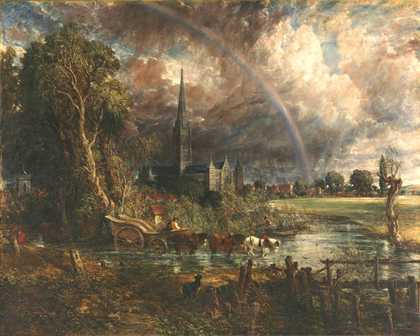
Fig.1
John Constable
Salisbury Cathedral from the Meadows exhibited 1831
Tate T13896
Although Constable knew that the sun must be directly behind the observer of a rainbow for the latter to be visible, this is plainly not so in this painting, in which the sun’s rays emerge from the right of the composition.3 Why should Constable be such a perfectionist about the weather in his scenes – his accurately depicted clouds, the effect of wind and harmonic daylight – and yet be content to introduce a meteorologically inconsistent rainbow? In an 1821 letter to his friend John Fisher the artist wrote:
The ‘skey’ is the source of light in nature – and governs everything … their difficulty in painting both as to composition and Execution is very great. Because with all their brilliancy and consequence – they ought not to come forward or be hardly thought about in a picture – any more than extreme distances are – But these remarks do not apply to phenomenon – or what the painters call accidental Effects of Skey – because they always attract particularly.4
Thus the rainbow and other optical effects, such as crepuscular rays (shafts of light that appear to emanate from the sun from its position behind a cloud), were given a special exemption by Constable, and although he believed that a rainbow must be parallel to the plane of a picture and should not ‘come forward’ in a scene (be shown at an angle or from its side), he made it clear that if he introduced such an effect he intended it to be both striking and ‘thought about’. In this case, the added rainbow is given scientifically accurate form – even though the process and timing of the original picture are compromised – in order to commemorate his friend’s untimely death.
Resting on Fisher’s house Leadenhall, the rainbow in Salisbury Cathedral from the Meadows has been painted into a sky that is lit by sunlight coming from due west, which is confirmed by the way light illuminates the west front of the cathedral. As this essay will show, a rainbow produced from this solar geometry and resting on Leadenhall would only have a height in the sky of up to about 22 degrees, and would occur in early August at around 5 pm Greenwich Mean Time (GMT).5 Constable has magnified the size of the cathedral and rendered the rainbow much taller than would have been possible. This confirms the theory that Constable added the full rainbow later, as it is not consistent with the lighting seen in the rest of the painting. Indeed, the late addition of the rainbow has been highlighted by Concannon, who states that none of the critics noted the rainbow in their discussions of the painting, despite their fixation on its atmospheric effects.6 This is supported by the fact that none of the surviving sketches for the finished work contained a rainbow (or lightning), although the plate in English Landscape Scenery entitled Salisbury Cathedral has a double rainbow that may be based on an untraced sketch of the cathedral.7
Beyond its commemorative effect and his own scientific interest, the rainbow was certainly an appealing emblem for Constable to use, representing on the one hand the symbolism of religious hope and grace for John Fisher, and on the other the crowning glory of his beloved chiaroscuro (contrast of light and shade) so as to note ‘the day, the hour, the sunshine, and the shade’.8 Constable may have also used the rainbow to represent public and private matters: in Salisbury Cathedral from the Meadows, it has been suggested that the rainbow symbolises not only the problems facing the Church of England at the time, but also problems in the artist’s own life.9 Constable’s ambition to be recognised in Britain for his art, and rewarded with the same kind of acclaim his works received in France, was his own tantalising rainbow. Whenever he seemed to be getting closer to success, like a rainbow it retreated away again. The fact that there is no correspondence relating to the introduction and direct purpose of the rainbow in Salisbury Cathedral from the Meadows (as opposed to its counterpart in print from c.1835, which gained the appendage ‘The Rainbow’ to its title) suggests that Constable wanted to keep that knowledge personal.
The Salisbury rainbow: Fact and fiction?
As well as the architecture of the cathedral, the representation of the weather in this painting dominates the image. Along with the rainbow we can see the dark threatening clouds of a thunderstorm, sheets of rain, a flash of lightning, patches of blue sky, bright sunlight and crepuscular rays, and it is possible to imagine the strong wind blowing back the branches of the huge sunlit ash tree. Close inspection shows that there is at least fifteen minutes’ worth of weather concertinaed into one moment of time. Creative license enabled Constable to carry this off and his knowledge of meteorology was such that the final product is much greater than the sum of its individual parts. The following detailed analysis of the solar geometry of the rainbow will provide a clearer sense of the interplay between science and artistic license in Salisbury Cathedral from the Meadows.

Table 1 gives the heights of the sun and rainbows at noon on the twenty-first day of each month of the year at 51 degrees north in Salisbury. It shows that the maximum height of the sun is approximately 62 degrees on 21 June, when the sun climbs to its highest point in the northern hemisphere summer. On this date, because the sunrise and sunset are so far apart in the day, it is possible for a rainbow to appear in Salisbury from approximately 4 am until 8.30 am and from around 3.30 pm until 8 pm. Thus in summer a rainbow over the cathedral is only possible in the early morning, late afternoon and early evening, with no chance of it appearing between 8.30 am and 3.30 pm. By contrast, a rainbow could be visible at any time of day between 21 September and 21 March.
Historian Paul D. Schweizer has attempted to show diagrammatically how the rainbow in Salisbury Cathedral from the Meadows defies meteorological science.10 His observation, based on an unpublished diagram by D. Gorczynski, is that the top of the bow subtends an angle of 38 degrees – meaning that if a line were drawn from the eye of the observer up to the top of the rainbow an angle of 38 degrees would be subtended. This is close to the maximum possible angle of 42 degrees, which would be produced when the sun is at the horizon. A re-examination of the painting suggests that the rainbow is in fact closer to the full 42-degree height, although the exact size is difficult to measure as the top of the bow is not visible in the painting.11 Such a rainbow, resting on Leadenhall and arching over the cathedral, would have been possible from Constable’s viewpoint on the afternoon of Fisher’s death on 25 August 1832.

Fig.2
Tim Tatton-Brown
Rainbow photograph taken from the Harnham Meadows, 29 September 2010
Photo © Tim Tatton-Brown
A convincing confirmation that such a rainbow is in fact plausible has been provided by the historian Tim Tatton-Brown, who also has located the exact viewpoint from which Salisbury Cathedral from the Meadows was painted – the ‘Longbridge’.12 Fig.2 shows a photograph taken from the Harnham Meadows, to the west of this viewpoint, close to sunset in late September, confirming the small size of the cathedral in comparison to a real, possibly full, 42-degree rainbow.13
Solar geometry confirms that from the viewpoint close to the Longbridge, a full 42-degree rainbow resting on Leadenhall and arching over the cathedral would have been visible during the late afternoon of 25 August at around 7 pm (GMT) (fig.3). Since the cathedral spire is roughly 610 metres away, a rainbow would appear over the cathedral with a height of about 549 metres.14
The spire is 123 metres tall and hence the full rainbow would be about four-and-a-half times taller than the cathedral, as is suggested in fig.2. As the cathedral is about halfway between the top of the rainbow and the base of the right-hand arch one
might expect that the rainbow should be at least twice the height
of the cathedral in the painting.
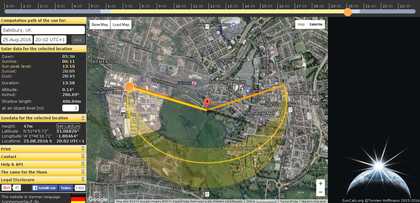
Fig.3
Solar geometry at the viewpoint from the Longbridge on 25 August at 7 pm (GMT), with the sun’s azimuth (direction in the sky) close to 287 degrees, altitude 0
Source: www.suncalc.org, © Torsten Hoffmann
The rainbow in the painting is therefore perfectly possible from the perspective of solar geometry. Aside from the rainbow, however, important inconsistencies in the solar geometry remain. The crepuscular rays that also fall on Leadenhall in the painting suggest that the sun is high in the sky to the west (fig.4). By measuring the angle of the crepuscular rays, Schweizer suggests that the sun has a height of 64 degrees in the painting, which is impossibly high. Furthermore, crepuscular rays are not vertical and are seen obliquely, such that measuring this angle is an imprecise means of establishing the height of the sun.
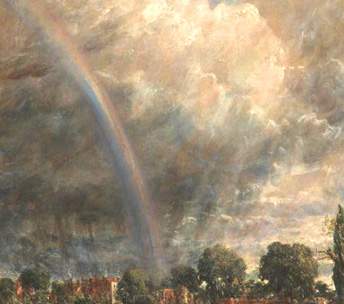
Fig.4
John Constable
Salisbury Cathedral from the Meadows, detail showing crepuscular rays
Photo © Tate

Fig.5
John Constable
Salisbury Cathedral from the Meadows, detail showing the post and its shadow
Photo © Tate
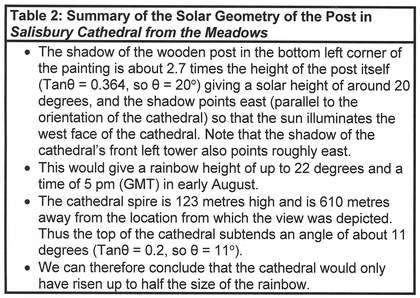
A better guide to the height of the sun in the sky in the picture is given by the shadow cast by the old post in the bottom left corner of the picture (fig.5), which Constable has indicated clearly and which reappears in later mezzotints of the painting. This shadow and the illumination of the west face of the cathedral suggest that the sun had reached an angle from the west that in early August would occur just after 5 pm (see table 2). By that time the height of the sun in the sky is about 20 degrees, meaning that a rainbow would have a height of up to about 22 degrees in the sky, which is significantly smaller than that observed in the painting. The rainbow would have appeared much flatter, although it would still have arched over the cathedral, rather more like the rainbow in David Lucas’s 1829 mezzotint of
Constable’s Stoke-by-Nayland, Suffolk (fig.6).
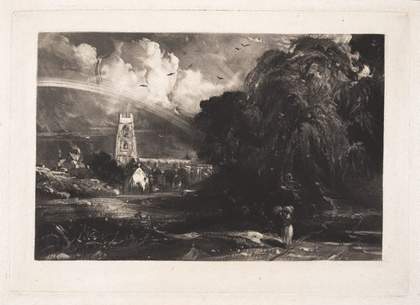
Fig.6
David Lucas after John Constable
Stoke-by-Nayland, Suffolk 1829
Art Gallery of New South Wales, Sydney
Had Constable used the solar geometry indicated by the shadow of the post, the depicted rainbow would not have been the one that the artist would see from the viewpoint at Longbridge, but one that would be seen by someone standing in the meadow on the right, at a similar viewpoint to that seen in fig.2. The lighting of the post confirms that the sun is to the right of the picture and not, as it should be, directly behind the observer. It is more than likely that Constable and Fisher would have observed rainbows from such a viewpoint to the west of the cathedral across the meadows, as in fig.2.
This reasoning suggests that Constable expressly chose to add the rainbow to a painting in which the sun is not directly behind the viewer as a magnificent remembrance of John Fisher. Constable certainly knew, as stated in his notes accompanying Stoke-by-Nayland, Suffolk in his print portfolio English Landscape Scenery, that a rainbow must always ‘be parallel with the plane of the picture’.15 Although the meteorological conditions seen in the painting – the late afternoon thunderstorm and the flashes of lightning – are conducive to the formation of a rainbow, in order to produce a complete bow that extends over the cathedral, the rain must have been falling directly over the building from the dark cloud at the top of the picture. It would appear therefore that Constable was quite willing to use artistic license for his ‘accidental Effect of Skey’ to commemorate his friend.
The interplay between art and the emerging science of meteorology was developing across Europe at the time that this painting was made. Chemist and amateur meteorologist Luke Howard’s cloud classifications of 1802 had an enormous influence on the poetry of Johann Wolfgang von Goethe (1749–1832). Goethe in turn implanted the idea in the painter Carl Gustav Carus (1789–1869) of what art historian Kurt Badt has termed the ‘production of modern art by means of science’,16 leading to art becoming, in the words of Carus, the ‘crown of science’.17 It would seem that Constable, building on the naturalism of seventeenth-century painters Peter Paul Rubens and Jacob van Ruisdael,18 the science of Howard and of Isaac Newton (1643–1727) and the literary culture of James Thomson (1700–1748) and William Wordsworth (1770–1850), made the decision to crown Salisbury Cathedral with a rainbow for John Fisher that moved his sky into the realm of symbolism and, in its heightened display of natural spectacle, the sublime.
Constable’s rainbow knowledge
Constable’s creative rendering of the rainbow in Salisbury Cathedral from the Meadows does not hide the fact that he understood contemporary meteorological theories about the formation of rainbows. As he had with clouds, Constable studied the available scientific literature on rainbows, observed actual rainbows in the sky and consulted his friends to enable him to understand this phenomenon. Although the primary source of his visual knowledge is not known, the extent of his rainbow knowledge is remarkable, as is revealed by a key passage in the print portfolio English Landscape Scenery. Plate seven of the portfolio, Stoke-by-Nayland, Suffolk (fig.6), depicts a rainbow arching over a village church at noon. The accompanying text states:
The solemn stillness of Nature in a Summer’s Noon, when attended by thunder clouds, is the sentiment attempted in this print; at the same time an endeavour has been made to give an additional interest to this Landscape by the introduction of the Rainbow, and other attending circumstances that might occur at such an hour. The effect of light and shadow on the sky and landscape are such as would be observed when looking to the northward at noon; that time of day being decidedly marked by the direction of the shadows and the sun shining full on the south side of the church.19
However, the angle of the rainbow in the mezzotint is about 20 degrees, which would mean that at noon the date would have to be in late January rather than summer (see table 1). Constable nonetheless goes on to show that he is fully aware of the importance of both the time of day and the day of the year in controlling the visible portion of a rainbow, and offers the following advice about the formation and form of rainbows for other landscape painters:
Of the rainbow – the following observations can hardly fail to be useful to the Landscape Painter. When the Rainbow appears at Noon, the height of the sun at that hour of the day causes but a small segment of the circle to be seen, and this gives the Bow its low or flat appearance: the Noon-day bow is therefore best seen ‘Smiling in a Winter’s day’, as in the summer, after the sun has passed a certain altitude, a Rainbow cannot appear.20
The 20-degree rainbow in Stoke-by-Nayland, Suffolk certainly does appear flattened, but it is inconsistent with his use of the picture to typify a ‘Summer’s Noon’, especially since, as table 1 shows, it is impossible to see a bow at noon in southern England between the beginning of April and the first week of September.
Constable continues with his observation ‘that a Rainbow can never appear foreshortened, or be seen obliquely, as it must be parallel with the plane of the picture, though a part of it only may be introduced’, and then discusses why the bow sometimes appears imperfect due to intervening cloud:
nor can a Rainbow be seen through any intervening cloud, however small or thin, as the reflected rays are dispersed by it, and are thus prevented from reaching the eye; consequently the Bow is imperfect in that part.21
The beauty of the rainbow is then praised by Constable, who refers to it as the ‘mild arch of promise’ – a sign of his investment in its symbolism. He goes on to discuss the effects seen at differing times of day and of multiple bows:
The morning and evening Bows are more frequent than those at noon, and are far more imposing and attractive from their loftiness and span; the colours are also more brilliant, ‘Flashing brief splendour through the clouds awhile.’ … For the same reason the exterior or secondary Bow is at these times also brighter, but the colours of it are reversed. A third, and even fourth Bow, may sometimes be seen, with the colours alternating in each; these are always necessarily fainter, from the quantity of light lost at each reflection within the drop, according to the received principle of the Bow.22
It was not until much later that it was widely appreciated that in fact the third and fourth bows are circles around the sun. Historian of science Carl Benjamin Boyer has suggested that Edmond Halley (1656–1742) had been the first to calculate this:
Halley seems to have been the earliest to carry through to the end the calculations on the tertiary rainbow; and the result must have been a surprise. He found that the third rainbow arc has an angular radius of 40° 20’ [minutes], and that it should appear not in the part of the heavens opposite the sun, but as a circle around the sun itself. For at least two thousand years men had been looking for this arc in the wrong part of the sky!23
The reason that the third and fourth bows are difficult to see is therefore due not only to their faintness, but is also a result of having to look in a direction towards the sun that is swamped by skylight. It is also likely that in many cases a different shower of rain from the one producing the primary and secondary bows is required, which may indeed prevent the primary and secondary bows being visible.

Fig.7
Joseph Mallord William Turner
Arundel Castle on the River Arun, with a Rainbow c.1824–5
Tate D18139, Turner Bequest CCVIII F
Photo © Tate
Constable concluded his discussion of the theory of rainbows by alluding to the difference between Newton’s seven prismatic colours of the rainbow (heptachromatic) and the three-coloured (trichromatic) rainbow that was used by many artists, including Constable and Turner – see, for instance, Turner’s watercolour Arundel Castle on the River Arun, with a Rainbow c.1824–5 (Tate D18139; fig.7).24 He also discussed the fact that the sky on the inside of a bow is lighter than the sky on the outside, remarking on Alexander’s Dark Band, the area between the primary and secondary bows:
Perhaps more remains yet to be discovered as to the cause of this most beautiful Phenomena of Light, recent experiments having proved that the primitive colours are further refrangible. Though not generally observed, the space within the Bow is always lighter than the outer portion of the cloud on which it is seen. This circumstance has not escaped the notice of the Poet, who with that intuitive feeling which has so often anticipated the discoveries of the Philosopher, remarks:
‘And all within the arch appeared to be
Brighter than that without.’25
Yet more detailed evidence of Constable’s understanding of the formation of rainbows is given in the four rainbow diagrams shown in figs.8a–d. These were probably part of Constable’s notes on skies that he mentioned to amateur painter and collector George Constable in 1836 that he might put together to give a lecture.26 The diagrams reveal several important facets of Constable’s knowledge.27 Firstly, they show that he was fully aware of the principles of reflection and refraction leading to the formation of the primary and secondary bows; secondly, they indicate that he knew the angles for the primary and secondary bows. Thirdly, in the diagram he lists the seven prismatic colours and draws three areas over the top to suggest the three primary colours, and writes further that ‘there is no limit to the number of prismatic colours’, suggesting that he was aware of the problems of defining Newton’s seven colours. Fourthly, Constable shows how a full circular bow may be seen by an observer on top of a hill, and finally he shows crescent-shaped raindrops which link to his friend George Field’s views on the subject expressed in his 1835 book Chromatography.28 Field believed that raindrops become lenticular (or lens-shaped) in form as they fall due to atmospheric friction.
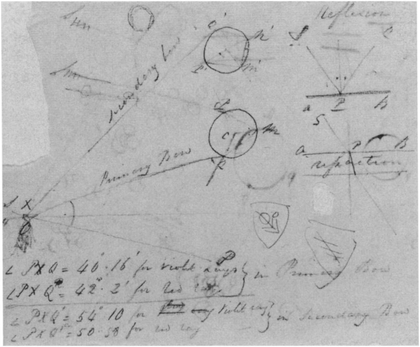
Fig.8a
John Constable
Rainbow diagram c.1832–6, recto of sheet ‘A’
Estate of Lt. Col. J.H. Constable
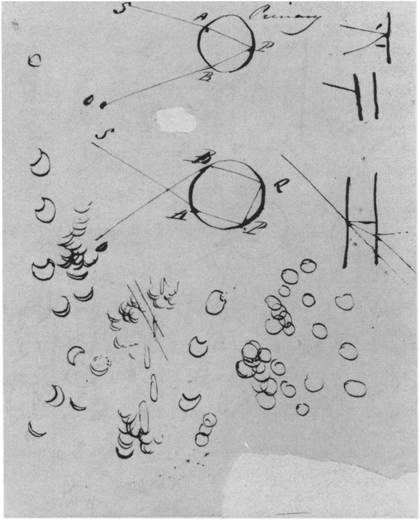
Fig.8b
John Constable
Rainbow diagram c.1832–6, verso of sheet ‘A’
Estate of Lt. Col. J.H. Constable
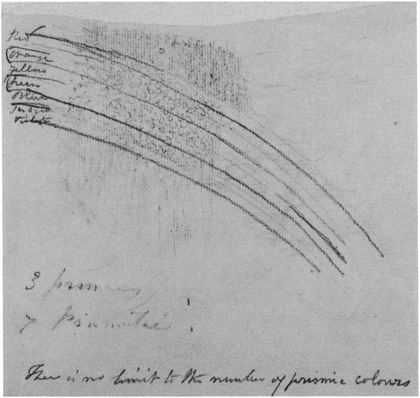
Fig.8c
John Constable
Rainbow diagram c.1832–6, recto of sheet ‘B’
Estate of Lt. Col. J.H. Constable
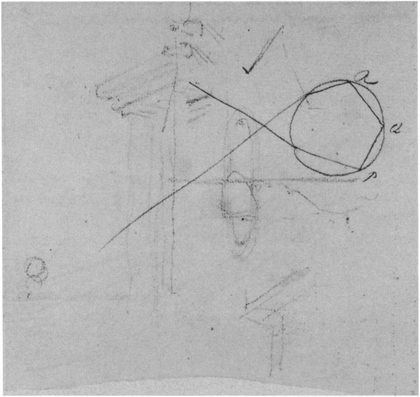
Fig.8d
John Constable
Rainbow diagram c.1832–6, verso of sheet ‘B’
Estate of Lt. Col. J.H. Constable
It is clear therefore that Constable was well aware of the fundamental contemporary principles of rainbow formation. The influence that this had upon his painting of rainbows is discussed in detail by Schweizer,29 who argues that from the rainbow diagrams it should have been clear to Constable that:
the width of the secondary arc of a rainbow is theoretically twice as wide as the primary arc, and that the width of the dark band of sky that separates the outermost band of red in the primary arc from the innermost red of the secondary arc is slightly less than three times the width of the secondary arc itself.30
This type of information would have been of great practical guidance to a landscape artist and Constable’s London, from Hampstead Heath in a Storm; with Double Rainbow Seen beneath Purple Masses of Cloud 1831 (fig.9) – the watercolour painted a few months after he exhibited Salisbury Cathedral from the Meadows at the Royal Academy, London – shows that he was fully aware of it. Here the secondary bow is certainly wider, at approximately 1.6 cm compared to 1.3 cm, which is equal to a 23 per cent difference, and the distance between the two bows (about 3.6 cm) is around 2.25 times the width of the secondary bow.31 This suggests that Constable painted the double bow by eye rather than by rule, but nevertheless his recently acquired knowledge would have helped him to confirm the theories he had studied: that the secondary bow is wider and that the colours – exemplary of the trichromatic scheme – are reversed.
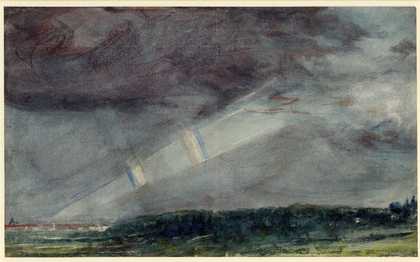
Fig.9
John Constable
London, from Hampstead Heath in a Storm; with Double Rainbow Seen beneath Purple Masses of Cloud 1831
British Museum, London
Interestingly, this double rainbow picture of Hampstead also shows converging rays of light which art historian Ian Fleming-Williams has compared to the painter C.R. Leslie’s 1845 description of such a phenomenon, as described to him by Constable:
I remember that he pointed out to me an appearance of the sun’s rays, which few artists have perhaps noticed, and which I never saw given in any picture, excepting in his Waterloo Bridge. When the spectator stands with his back to the sun, the rays may be sometimes seen converging in perspective towards the opposite horizon. Since he drew my attention to such effects, I have noticed very early in the morning the lines of the rays diminishing in perspective through a rainbow.32
Light rays that converge opposite the sun are called anticrepuscular rays, but these are rarely seen. When such anticrepuscular rays happen to intercept a rainbow the result is what is called a ‘rainbow wheel’, and astronomers David K. Lynch and William Livingston state that London, from Hampstead Heath in a Storm contains a ‘nice rainbow wheel’.33 It could be that Constable was the first to notice such effects and that Leslie’s recollections may be the first published observations of anticrepuscular rays and the rainbow wheel.
Critics’ reaction to the sky and Constable’s response
Despite its powerful symbolic rendering, the sky in Salisbury Cathedral from the Meadows attracted harsh criticism, with one critic stating that ‘This will be a good picture in the days to come. At present it is too immediately after the rain, and everything is so vivid and bright, that it seems to touch the eye.’34 Further reviews asserted that:
The inky clouds, and the shower of meal that seems to be falling in the foreground, destroy the keeping and natural effect. Mr. CONSTABLE once painted with equal truth and freshness, but he sacrifices these real qualities to a trick of art.35
What season of the year is intended to be depicted…? … from the face of that scene, the snow seems melting away; the lightning is glaring, not flashing through the trees; and all the winds of heaven seem hurling the clouds about in every imaginable form and confusion.36
It is presumed, from the lines quoted from Thomson, to represent the clearing up of a shower; but there is nothing like a clearing up about it.37
Constable was aware of the extent of the criticism, and after reading the review in the Library of the Fine Arts he wrote in a letter to Leslie on 2 June 1831:
they speak … perhaps fairly, of my ‘chaos’ as they term the Salisbury. They say (after much abuse & faults), ‘it is still a picture from which it is impossible to turn without admiration’.38
That no critics mention the rainbow is a further sign that it was added later, after the painting was first exhibited.39 Yet the question remains as to why Constable should have become so obsessed with rainbows at this late stage in his career. On 6 September 1835 he wrote to Lucas regarding the rainbow in the mezzotint of the Salisbury painting (see, for example, Salisbury Cathedral from the Meadows – ‘The Rainbow’ c.1835, private collection):
If it is not exquisitely done, if it is not tender – and elegant – evernescent [sic] and lovely – in the highest degree – we are both ruined. I am led to this having been very busy with rainbows – and very happy in doing them – by the above rules.40
The reference to ‘the above rules’ is not clear but it may relate to the chromascope, which was invented by George Field. According to Field, this device ‘affords a method by which a rainbow, of any arc, may be superinduced upon a picture into which the artist may design to introduce it, so as to try its effect, and the best way of accomplishing it’.41 Lucas reduced the width of the bow when working on the plate, which may suggests that some device or set of rules had been applied. In March 1837, in what was probably his last letter to Lucas, Constable stated that he had redrawn the arc of the rainbow in the print so that, as art historian Timothy Wilcox notes, it could ‘be centred on a blossom on an elder bush (at the foot of the tall ash, behind the wagon) … Constable knew that the plant was associated with death.’42
London, from Hampstead Heath in a Storm demonstrates that Constable was fully familiar with contemporary rainbow science by the end of 1831. His discussion of rainbow geometry in his analysis of the rainbow in the mezzotint Stoke-by-Nayland, Suffolk in English Landscape Scenery only confirms the extensive rainbow knowledge he possessed. As this essay has shown, the sight of a full 42-degree rainbow – that which Constable painted in Salisbury Cathedral from the Meadows – is perfectly possible from the Longbridge viewpoint but is incompatible with the light scheme of the painting: the solar geometry, as calculated from the shadow of the post, is conducive to a much smaller 22-degree rainbow, lit from the west. This works with the absence of reference to the rainbow by the critics in 1831 to suggest that this natural spectacle was not part of the painting’s original composition but rather an afterthought, added after its public debut. The 42-degree rainbow – of the kind seen in the sky just before sunset – rests poignantly on the house of Fisher, who died on 25 August 1832. His death is thereby the likely impetus behind and timing of the rainbow’s addition by Constable, a visual iteration of his wish that ‘God bless him till we meet again’.43 In the context of troubled times for the Church of England, Fisher’s reference to the concept for the painting as being ‘The Church under a cloud’44 implies that Constable’s sky in Salisbury Cathedral from the Meadows was always going to move beyond realism and into symbolism. The addition of the rainbow, Constable’s ‘mild arch of promise’, upon the death of Fisher may have been an attempt to inject a peaceful, hopeful note in an otherwise tempestuous sky. Inconsistencies such as the exaggerated height of the cathedral in relation to the rainbow, which ought to soar even higher above it, reveal a dual purpose on the part of the painter, wherein the magnificence and the symbolism of a stormy summer sky could be explored and could run in parallel with his knowledge of the latest theories in meteorological science.45
